Review of Radiation-Induced Effects on β-Ga2O3 Materials and Devices
Abstract
:1. Introduction
2. Defects and Radiation-Induced Defects
3. Space Radiation
4. Radiation Damage in Ga2O3
4.1. Heavy Ions (Protons and SHI)
4.1.1. Heavy Ions
4.1.2. Protons
4.2. Neutrons
4.3. Electrons
4.4. Gamma and X-rays
4.4.1. Gamma
4.4.2. X-rays
5. Future Perspectives
6. Conclusions
Author Contributions
Funding
Institutional Review Board Statement
Informed Consent Statement
Data Availability Statement
Acknowledgments
Conflicts of Interest
References
- Pearton, S.J.; Yang, J.; Cary, P.H.; Ren, F.; Kim, J.; Tadjer, M.J.; Mastro, M.A. A review of Ga2O3 materials, processing, and devices. Appl. Phys. Rev. 2018, 5, 011301. [Google Scholar] [CrossRef] [Green Version]
- Jones, E.A.; Wang, F.F.; Costinett, D. Review of Commercial GaN Power Devices and GaN-Based Converter Design Challenges. IEEE J. Emerg. Sel. Top. Power Electron. 2016, 4, 707–719. [Google Scholar] [CrossRef]
- Chen, K.J.; Haberlen, O.; Lidow, A.; Tsai, C.L.; Ueda, T.; Uemoto, Y.; Wu, Y. GaN-on-Si Power Technology: Devices and Applications. IEEE Trans. Electron Devices 2017, 64, 779–795. [Google Scholar] [CrossRef]
- Chow, T.P.; Tyagi, R. Wide bandgap compound semiconductors for superior high-voltage power devices. In Proceedings of the 5th International Symposium on Power Semiconductor Devices and ICs, Monterey, CA, USA, 18–20 May 1993; pp. 84–88. [Google Scholar]
- Weitzel, C.E.; Palmour, J.W.; Carter, C.H.; Moore, K.; Nordquist, K.K.; Allen, S.; Thero, C.; Bhatnagar, M. Silicon carbide high-power devices. IEEE Trans. Electron Devices 1996, 43, 1732–1741. [Google Scholar] [CrossRef]
- Pearton, S.J.; Aitkaliyeva, A.; Xian, M.; Ren, F.; Khachatrian, A.; Ildefonso, A.; Islam, Z.; Jafar Rasel, M.A.; Haque, A.; Polyakov, A.Y.; et al. Review—Radiation Damage in Wide and Ultra-Wide Bandgap Semiconductors. ECS J. Solid State Sci. Technol. 2021, 10, 055008. [Google Scholar] [CrossRef]
- Kim, M.; Seo, J.-H.; Singisetti, U.; Ma, Z. Recent advances in free-standing single crystalline wide bandgap semiconductors and their applications: GaN, SiC, ZnO, β-Ga2O3, and diamond. J. Mater. Chem. C 2017, 5, 8338–8354. [Google Scholar] [CrossRef]
- Millan, J.; Godignon, P.; Perpina, X.; Perez-Tomas, A.; Rebollo, J. A Survey of Wide Bandgap Power Semiconductor Devices. IEEE Trans. Power Electron. 2014, 29, 2155–2163. [Google Scholar] [CrossRef]
- Higashiwaki, M.; Jessen, G.H. Guest Editorial: The dawn of gallium oxide microelectronics. Appl. Phys. Lett. 2018, 112, 060401. [Google Scholar] [CrossRef] [Green Version]
- Zhang, J.; Shi, J.; Qi, D.-C.; Chen, L.; Zhang, K.H.L. Recent progress on the electronic structure, defect, and doping properties of Ga2O3. APL Mater. 2020, 8, 020906. [Google Scholar] [CrossRef] [Green Version]
- Bosi, M.; Mazzolini, P.; Seravalli, L.; Fornari, R. Ga2O3 polymorphs: Tailoring the epitaxial growth conditions. J. Mater. Chem. C 2020, 8, 10975–10992. [Google Scholar] [CrossRef]
- Galazka, Z. β-Ga2O3 for wide-bandgap electronics and optoelectronics. Semicond. Sci. Technol. 2018, 33, 113001. [Google Scholar] [CrossRef]
- Baliga, B.J. Semiconductors for high-voltage, vertical channel field-effect transistors. J. Appl. Phys. 1982, 53, 1759–1764. [Google Scholar] [CrossRef]
- Baliga, B.J. Power semiconductor device figure of merit for high-frequency applications. IEEE Electron Device Lett. 1989, 10, 455–457. [Google Scholar] [CrossRef]
- Higashiwaki, M.; Sasaki, K.; Murakami, H.; Kumagai, Y.; Koukitu, A.; Kuramata, A.; Masui, T.; Yamakoshi, S. Recent progress in Ga2O3 power devices. Semicond. Sci. Technol. 2016, 31, 034001. [Google Scholar] [CrossRef]
- Zhang, H.; Yuan, L.; Tang, X.; Hu, J.; Sun, J.; Zhang, Y.; Zhang, Y.; Jia, R. Progress of Ultra-Wide Bandgap Ga2O3 Semiconductor Materials in Power MOSFETs. IEEE Trans. Power Electron. 2020, 35, 5157–5179. [Google Scholar] [CrossRef]
- Pearton, S.J.; Ren, F.; Tadjer, M.; Kim, J. Perspective: Ga2O3 for ultra-high power rectifiers and MOSFETS. J. Appl. Phys. 2018, 124, 220901. [Google Scholar] [CrossRef] [Green Version]
- del Alamo, J.A.; Joh, J. GaN HEMT reliability. Microelectron. Reliab. 2009, 49, 1200–1206. [Google Scholar] [CrossRef]
- Amano, H.; Baines, Y.; Beam, E.; Borga, M.; Bouchet, T.; Chalker, P.R.; Charles, M.; Chen, K.J.; Chowdhury, N.; Chu, R.; et al. The 2018 GaN power electronics roadmap. J. Phys. D Appl. Phys. 2018, 51, 163001. [Google Scholar] [CrossRef]
- Zhang, Y.; Dadgar, A.; Palacios, T. Gallium nitride vertical power devices on foreign substrates: A review and outlook. J. Phys. D Appl. Phys. 2018, 51, 273001. [Google Scholar] [CrossRef]
- Luo, Z.; Chen, T.; Sheridan, D.C.; Cressler, J.D. 4H-SiC Power-Switching Devices for Extreme-Environment Applications. In SiC Power Materials; Springer: Berlin/Heidelberg, Germany, 2004; pp. 375–409. [Google Scholar]
- Wang, J.; Mulligan, P.; Brillson, L.; Cao, L.R. Review of using gallium nitride for ionizing radiation detection. Appl. Phys. Rev. 2015, 2, 031102. [Google Scholar] [CrossRef] [Green Version]
- Pearton, S.J.; Hwang, Y.-S.; Ren, F. Radiation Effects in GaN-Based High Electron Mobility Transistors. JOM 2015, 67, 1601–1611. [Google Scholar] [CrossRef]
- Scozzie, C.J.; McGarrity, J.M.; Blackburn, J.; DeLancey, W.M. Silicon carbide FETs for high temperature nuclear environments. IEEE Trans. Nucl. Sci. 1996, 43, 1642–1648. [Google Scholar] [CrossRef] [Green Version]
- Lee, K.K.; Ohshima, T.; Itoh, H. Performance of Gamma irradiated P-channel 6H SiC MOSFETs: High total dose. IEEE Trans. Nucl. Sci. 2003, 50, 194–200. [Google Scholar] [CrossRef]
- Javanainen, A.; Galloway, K.F.; Nicklaw, C.; Bosser, A.L.; Ferlet-Cavrois, V.; Lauenstein, J.-M.; Pintacuda, F.; Reed, R.A.; Schrimpf, R.D.; Weller, R.A.; et al. Heavy Ion Induced Degradation in SiC Schottky Diodes: Bias and Energy Deposition Dependence. IEEE Trans. Nucl. Sci. 2017, 64, 415–420. [Google Scholar] [CrossRef] [Green Version]
- Bayu Aji, L.B.; Wallace, J.B.; Kucheyev, S.O. Effects of collision cascade density on radiation defect dynamics in 3C-SiC. Sci. Rep. 2017, 7, 44703. [Google Scholar] [CrossRef] [Green Version]
- Sall, M.; Monnet, I.; Moisy, F.; Grygiel, C.; Jublot-Leclerc, S.; Della–Negra, S.; Toulemonde, M.; Balanzat, E. Track formation in III-N semiconductors irradiated by swift heavy ions and fullerene and re-evaluation of the inelastic thermal spike model. J. Mater. Sci. 2015, 50, 5214–5227. [Google Scholar] [CrossRef]
- Polyakov, A.Y.; Pearton, S.J.; Frenzer, P.; Ren, F.; Liu, L.; Kim, J. Radiation effects in GaN materials and devices. J. Mater. Chem. C 2013, 1, 877–887. [Google Scholar] [CrossRef]
- Pearton, S.J.; Ren, F.; Patrick, E.; Law, M.E.; Polyakov, A.Y. Review—Ionizing Radiation Damage Effects on GaN Devices. ECS J. Solid State Sci. Technol. 2016, 5, Q35–Q60. [Google Scholar] [CrossRef] [Green Version]
- Polyakov, A.Y.; Smirnov, N.B.; Govorkov, A.V.; Markov, A.V.; Pearton, S.J.; Kolin, N.G.; Merkurisov, D.I.; Boiko, V.M.; Lee, C.-R.; Lee, I.-H. Fast neutron irradiation effects in n-GaN. J. Vac. Sci. Technol. B Microelectron. Nanom. Struct. 2007, 25, 436. [Google Scholar] [CrossRef]
- Polyakov, A.Y.; Smirnov, N.B.; Govorkov, A.V.; Markov, A.V.; Kolin, N.G.; Merkurisov, D.I.; Boiko, V.M.; Shcherbatchev, K.D.; Bublik, V.T.; Voronova, M.I.; et al. Neutron irradiation effects in p-GaN. J. Vac. Sci. Technol. B Microelectron. Nanom. Struct. 2006, 24, 2256. [Google Scholar] [CrossRef]
- Polyakov, A.Y.; Smirnov, N.B.; Govorkov, A.V.; Markov, A.V.; Kolin, N.G.; Merkurisov, D.I.; Boiko, V.M.; Shcherbatchev, K.D.; Bublik, V.T.; Voronova, M.I.; et al. Fermi level pinning in heavily neutron-irradiated GaN. J. Appl. Phys. 2006, 100, 093715. [Google Scholar] [CrossRef]
- Ionascut-Nedelcescu, A.; Carlone, C.; Houdayer, A.; von Bardeleben, H.J.; Cantin, J.-L.; Raymond, S. Radiation hardness of gallium nitride. IEEE Trans. Nucl. Sci. 2002, 49, 2733–2738. [Google Scholar] [CrossRef]
- Polyakov, A.; Usikov, A.; Theys, B.; Smirnov, N.; Govorkov, A.; Jomard, F.; Shmidt, N.; Lundin, W. Effects of proton implantation on electrical and recombination properties of n-GaN. Solid. State. Electron. 2000, 44, 1971–1983. [Google Scholar] [CrossRef]
- Kumar, A.; Kumar, T.; Hähnel, A.; Kanjilal, D.; Singh, R. Dynamics of modification of Ni/n-GaN Schottky barrier diodes irradiated at low temperature by 200 MeV Ag14+ ions. Appl. Phys. Lett. 2014, 104, 033507. [Google Scholar] [CrossRef]
- Kumar, A.; Hähnel, A.; Kanjilal, D.; Singh, R. Electrical and microstructural analyses of 200 MeV Ag14+ ion irradiated Ni/GaN Schottky barrier diode. Appl. Phys. Lett. 2012, 101, 153508. [Google Scholar] [CrossRef] [Green Version]
- Harris, R.D.; Frasca, A.J.; Patton, M.O. Displacement damage effects on the forward bias characteristics of SiC Schottky barrier power diodes. IEEE Trans. Nucl. Sci. 2005, 52, 2408–2412. [Google Scholar] [CrossRef]
- Mizuta, E.; Kuboyama, S.; Abe, H.; Iwata, Y.; Tamura, T. Investigation of Single-Event Damages on Silicon Carbide (SiC) Power MOSFETs. IEEE Trans. Nucl. Sci. 2014, 61, 1924–1928. [Google Scholar] [CrossRef]
- Bernat, R.; Capan, I.; Bakrač, L.; Brodar, T.; Makino, T.; Ohshima, T.; Pastuović, Ž.; Sarbutt, A. Response of 4H-SiC Detectors to Ionizing Particles. Crystals 2020, 11, 10. [Google Scholar] [CrossRef]
- Metzger, S.; Henschel, H.; Kohn, O.; Lennartz, W. Silicon carbide radiation detector for harsh environments. IEEE Trans. Nucl. Sci. 2002, 49, 1351–1355. [Google Scholar] [CrossRef]
- Lee, K.-M.; Park, B.-G. Estimation of Residual Radioactivity and Radiation Damage in SiC After Neutron Irradiation. IEEE Trans. Nucl. Sci. 2020, 67, 1374–1380. [Google Scholar] [CrossRef]
- La Via, F.; Tudisco, S.; Altana, C.; Boscardin, M.; Ciampi, C.; Cirrone, G.A.P.; Fazzi, A.; Giove, D.; Gorini, G.; Lanzalone, G.; et al. Silicon Carbide devices for radiation detection and measurements. J. Phys. Conf. Ser. 2020, 1561, 012013. [Google Scholar] [CrossRef]
- Fu, B.; Jia, Z.; Mu, W.; Yin, Y.; Zhang, J.; Tao, X. A review of β-Ga2O3 single crystal defects, their effects on device performance and their formation mechanism. J. Semicond. 2019, 40, 011804. [Google Scholar] [CrossRef]
- Xue, H.; He, Q.; Jian, G.; Long, S.; Pang, T.; Liu, M. An Overview of the Ultrawide Bandgap Ga2O3 Semiconductor-Based Schottky Barrier Diode for Power Electronics Application. Nanoscale Res. Lett. 2018, 13, 290. [Google Scholar] [CrossRef] [PubMed] [Green Version]
- Huan, Y.-W.; Sun, S.-M.; Gu, C.-J.; Liu, W.-J.; Ding, S.-J.; Yu, H.-Y.; Xia, C.-T.; Zhang, D.W. Recent Advances in β-Ga2O3–Metal Contacts. Nanoscale Res. Lett. 2018, 13, 246. [Google Scholar] [CrossRef] [PubMed]
- Chabak, K.D.; Leedy, K.D.; Green, A.J.; Mou, S.; Neal, A.T.; Asel, T.; Heller, E.R.; Hendricks, N.S.; Liddy, K.; Crespo, A.; et al. Lateral β-Ga2O3 field effect transistors. Semicond. Sci. Technol. 2020, 35, 013002. [Google Scholar] [CrossRef] [Green Version]
- Tadjer, M.J.; Lyons, J.L.; Nepal, N.; Freitas, J.A.; Koehler, A.D.; Foster, G.M. Editors’ Choice—Review—Theory and Characterization of Doping and Defects in β-Ga2O3. ECS J. Solid State Sci. Technol. 2019, 8, Q3187–Q3194. [Google Scholar] [CrossRef]
- Sheoran, H.; Tak, B.R.; Manikanthababu, N.; Singh, R. Temperature-Dependent Electrical Characteristics of Ni/Au Vertical Schottky Barrier Diodes on β-Ga2O3 Epilayers. ECS J. Solid State Sci. Technol. 2020, 9, 055004. [Google Scholar] [CrossRef]
- Sheoran, H.; Kumar, V.; Singh, R. A Comprehensive Review on Recent Developments in Ohmic and Schottky Contacts on Ga2O3 for Device Applications. ACS Appl. Electron. Mater. 2022, 4, 2589–2628. [Google Scholar] [CrossRef]
- Wong, M.H.; Higashiwaki, M. Vertical β -Ga₂O₃ Power Transistors: A Review. IEEE Trans. Electron Devices 2020, 67, 3925–3937. [Google Scholar] [CrossRef]
- Nikolskaya, A.; Okulich, E.; Korolev, D.; Stepanov, A.; Nikolichev, D.; Mikhaylov, A.; Tetelbaum, D.; Almaev, A.; Bolzan, C.A.; Buaczik, A.; et al. Ion implantation in β-Ga2O3: Physics and technology. J. Vac. Sci. Technol. A 2021, 39, 030802. [Google Scholar] [CrossRef]
- Kim, J.; Pearton, S.J.; Fares, C.; Yang, J.; Ren, F.; Kim, S.; Polyakov, A.Y. Radiation damage effects in Ga2O3 materials and devices. J. Mater. Chem. C 2019, 7, 10–24. [Google Scholar] [CrossRef]
- McCluskey, M.D. Point defects in Ga2O3. J. Appl. Phys. 2020, 127, 101101. [Google Scholar] [CrossRef] [Green Version]
- Varley, J.B.; Weber, J.R.; Janotti, A.; Van de Walle, C.G. Oxygen vacancies and donor impurities in β-Ga2O3. Appl. Phys. Lett. 2010, 97, 142106. [Google Scholar] [CrossRef]
- Ahmadi, E.; Koksaldi, O.S.; Kaun, S.W.; Oshima, Y.; Short, D.B.; Mishra, U.K.; Speck, J.S. Ge doping of β-Ga2O3 films grown by plasma-assisted molecular beam epitaxy. Appl. Phys. Express 2017, 10, 041102. [Google Scholar] [CrossRef]
- Lyons, J.L. A survey of acceptor dopants for β-Ga2O3. Semicond. Sci. Technol. 2018, 33, 05LT02. [Google Scholar] [CrossRef]
- Frodason, Y.K.; Johansen, K.M.; Vines, L.; Varley, J.B. Self-trapped hole and impurity-related broad luminescence in β -Ga2O3. J. Appl. Phys. 2020, 127, 075701. [Google Scholar] [CrossRef]
- Chen, X.; Ren, F.; Gu, S.; Ye, J. Review of gallium-oxide-based solar-blind ultraviolet photodetectors. Photonics Res. 2019, 7, 381. [Google Scholar] [CrossRef]
- Nakai, K.; Nagai, T.; Noami, K.; Futagi, T. Characterization of defects in β-Ga2O3 single crystals. Jpn. J. Appl. Phys. 2015, 54, 051103. [Google Scholar] [CrossRef]
- Ueda, O.; Ikenaga, N.; Koshi, K.; Iizuka, K.; Kuramata, A.; Hanada, K.; Moribayashi, T.; Yamakoshi, S.; Kasu, M. Structural evaluation of defects in β-Ga2O3 single crystals grown by edge-defined film-fed growth process. Jpn. J. Appl. Phys. 2016, 55, 1202BD. [Google Scholar] [CrossRef]
- Hanada, K.; Moribayashi, T.; Uematsu, T.; Masuya, S.; Koshi, K.; Sasaki, K.; Kuramata, A.; Ueda, O.; Kasu, M. Observation of nanometer-sized crystalline grooves in as-grown β-Ga2O3 single crystals. Jpn. J. Appl. Phys. 2016, 55, 030303. [Google Scholar] [CrossRef]
- Zhang, Z.; Farzana, E.; Arehart, A.R.; Ringel, S.A. Deep level defects throughout the bandgap of (010) β-Ga2O3 detected by optically and thermally stimulated defect spectroscopy. Appl. Phys. Lett. 2016, 108, 052105. [Google Scholar] [CrossRef]
- Ghadi, H.; McGlone, J.F.; Jackson, C.M.; Farzana, E.; Feng, Z.; Bhuiyan, A.F.M.A.U.; Zhao, H.; Arehart, A.R.; Ringel, S.A. Full bandgap defect state characterization of β-Ga2O3 grown by metal organic chemical vapor deposition. APL Mater. 2020, 8, 021111. [Google Scholar] [CrossRef] [Green Version]
- Cucinotta, F.A.; Hu, S.; Schwadron, N.A.; Kozarev, K.; Townsend, L.W.; Kim, M.-H.Y. Space radiation risk limits and Earth-Moon-Mars environmental models. Sp. Weather 2010, 8, S00E09. [Google Scholar] [CrossRef]
- Maurer, R.; Fraeman, M. RHarsh Environments: Space Radiation. Johns Hopkins APL 2008, 28, 17–29. [Google Scholar]
- Liu, C.; Berencén, Y.; Yang, J.; Wei, Y.; Wang, M.; Yuan, Y.; Xu, C.; Xie, Y.; Li, X.; Zhou, S. Irradiation effects on the structural and optical properties of single crystal β-Ga2O3. Semicond. Sci. Technol. 2018, 33, 095022. [Google Scholar] [CrossRef]
- Yadav, S.; Dash, S.; Patra, A.K.; Umapathy, G.R.; Ojha, S.; Patel, S.P.; Singh, R.; Katharria, Y.S. Effects of Energetic Ion Irradiation on β-Ga2O3 Thin Films. ECS J. Solid State Sci. Technol. 2020, 9, 045015. [Google Scholar] [CrossRef]
- Ai, W.; Xu, L.; Nan, S.; Zhai, P.; Li, W.; Li, Z.; Hu, P.; Zeng, J.; Zhang, S.; Liu, L.; et al. Radiation damage in β-Ga2O3 induced by swift heavy ions. Jpn. J. Appl. Phys. 2019, 58, 120914. [Google Scholar] [CrossRef]
- Manikanthababu, N.; Tak, B.R.; Prajna, K.; Sarkar, S.; Meena, R.C.; Asokan, K.; Barman, S.R.; Singh, R.; Panigrahi, B.K. Electronic excitation-induced tunneling and charge-trapping explored by in situ electrical characterization in Ni/HfO2/β-Ga2O3 metal–oxide–semiconductor capacitors. Mater. Sci. Eng. B Solid-State Mater. Adv. Technol. 2022, 281, 115716. [Google Scholar] [CrossRef]
- Manikanthababu, N.; Tak, B.R.; Sheoran, H.; Prajna, K.; Panigrahi, B.K.; Singh, R. Exploring current conduction mechanisms in 6 MeV Si3+ ion irradiated Au/SiO2/beta-Ga2O3 metal-oxide-semiconductor devices. In Proceedings of the 2020 5th IEEE International Conference on Emerging Electronics, ICEE 2020, New Delhi, India, 26–28 November 2020; pp. 1–4. [Google Scholar] [CrossRef]
- Tracy, C.L.; Lang, M.; Severin, D.; Bender, M.; Trautmann, C.; Ewing, R.C. Anisotropic expansion and amorphization of Ga2O3 irradiated with 946 MeV Au ions. Nucl. Instrum. Methods Phys. Res. Sect. B Beam Interact. Mater. Atoms 2016, 374, 40–44. [Google Scholar] [CrossRef] [Green Version]
- Manikanthababu, N.; Chan, T.K.; Vajandar, S.; Saikiran, V.; Pathak, A.P.; Osipowicz, T.; Rao, S.V.S.N. Ion induced intermixing and consequent effects on the leakage currents in HfO2/SiO2/Si systems. Appl. Phys. A 2017, 123, 303. [Google Scholar] [CrossRef]
- Manikanthababu, N.; Vajandar, S.; Arun, N.; Pathak, A.P.; Asokan, K.; Osipowicz, T.; Basu, T.; Nageswara Rao, S.V.S. Electronic excitation induced defect dynamics in HfO2 based MOS devices investigated by in-situ electrical measurements. Appl. Phys. Lett. 2018, 112, 131601. [Google Scholar] [CrossRef]
- Manikanthababu, N.; Tak, B.R.; Prajna, K.; Sarkar, S.; Asokan, K.; Kanjilal, D.; Barman, S.R.; Singh, R.; Panigrahi, B.K. Swift heavy ion irradiation-induced modifications in the electrical and surface properties of β-Ga2O3. Appl. Phys. Lett. 2020, 117, 142105. [Google Scholar] [CrossRef]
- Ingebrigtsen, M.E.; Kuznetsov, A.Y.; Svensson, B.G.; Alfieri, G.; Mihaila, A.; Badstübner, U.; Perron, A.; Vines, L.; Varley, J.B. Impact of proton irradiation on conductivity and deep level defects in β-Ga2O3. APL Mater. 2019, 7, 022510. [Google Scholar] [CrossRef] [Green Version]
- Modak, S.; Chernyak, L.; Khodorov, S.; Lubomirsky, I.; Ruzin, A.; Xian, M.; Ren, F.; Pearton, S.J. Effect of Electron Injection on Minority Carrier Transport in 10 MeV Proton Irradiated β-Ga2O3 Schottky Rectifiers. ECS J. Solid State Sci. Technol. 2020, 9, 045018. [Google Scholar] [CrossRef]
- Gao, H.; Muralidharan, S.; Pronin, N.; Karim, M.R.; White, S.M.; Asel, T.; Foster, G.; Krishnamoorthy, S.; Rajan, S.; Cao, L.R.; et al. Optical signatures of deep level defects in Ga2O3. Appl. Phys. Lett. 2018, 112, 242102. [Google Scholar] [CrossRef]
- Gao, H.; Muralidharan, S.; Karim, M.R.; White, S.M.; Cao, L.R.; Leedy, K.; Zhao, H.; Look, D.C.; Brillson, L.J. Neutron irradiation and forming gas anneal impact on β-Ga2O3 deep level defects. J. Phys. D Appl. Phys. 2020, 53, 465102. [Google Scholar] [CrossRef]
- Farzana, E.; Chaiken, M.F.; Blue, T.E.; Arehart, A.R.; Ringel, S.A. Impact of deep level defects induced by high energy neutron radiation in β-Ga2O3. APL Mater. 2019, 7, 022502. [Google Scholar] [CrossRef] [Green Version]
- Yang, J.; Ren, F.; Pearton, S.J.; Yang, G.; Kim, J.; Kuramata, A. 1.5 MeV electron irradiation damage in β-Ga2O3 vertical rectifiers. J. Vac. Sci. Technol. B Nanotechnol. Microelectron. Mater. Process. Meas. Phenom. 2017, 35, 031208. [Google Scholar] [CrossRef]
- Lee, J.; Flitsiyan, E.; Chernyak, L.; Yang, J.; Ren, F.; Pearton, S.J.; Meyler, B.; Salzman, Y.J. Effect of 1.5 MeV electron irradiation on β-Ga2O3 carrier lifetime and diffusion length. Appl. Phys. Lett. 2018, 112, 082104. [Google Scholar] [CrossRef] [Green Version]
- Yang, J.; Koller, G.J.; Fares, C.; Ren, F.; Pearton, S.J.; Bae, J.; Kim, J.; Smith, D.J. 60 Co Gamma Ray Damage in Homoepitaxial β-Ga2O3 Schottky Rectifiers. ECS J. Solid State Sci. Technol. 2019, 8, Q3041–Q3045. [Google Scholar] [CrossRef]
- Wong, M.H.; Takeyama, A.; Makino, T.; Ohshima, T.; Sasaki, K.; Kuramata, A.; Yamakoshi, S.; Higashiwaki, M. Radiation hardness of β-Ga2O3 metal-oxide-semiconductor field-effect transistors against gamma-ray irradiation. Appl. Phys. Lett. 2018, 112, 023503. [Google Scholar] [CrossRef]
- Tak, B.R.; Garg, M.; Kumar, A.; Gupta, V.; Singh, R. Gamma Irradiation Effect on Performance of β-Ga2O3 Metal-Semiconductor-Metal Solar-Blind Photodetectors for Space Applications. ECS J. Solid State Sci. Technol. 2019, 8, Q3149–Q3153. [Google Scholar] [CrossRef]
- Manikanthababu, N.; Tak, B.R.; Prajna, K.; Singh, R.; Panigrahi, B.K. Radiation sustenance of HfO2/β-Ga2O3 metal-oxide-semiconductor capacitors: Gamma irradiation study. Semicond. Sci. Technol. 2020, 35, 055024. [Google Scholar] [CrossRef]
- Bhuiyan, M.A.; Zhou, H.; Jiang, R.; Zhang, E.X.; Fleetwood, D.M.; Ye, P.D.; Ma, T.-P. Charge Trapping in Al2O3/β-Ga2O3-Based MOS Capacitors. IEEE Electron. Device Lett. 2018, 39, 1022–1025. [Google Scholar] [CrossRef]
- Chen, J.-X.; Li, X.-X.; Huang, W.; Ji, Z.-G.; Wu, S.-Z.; Xiao, Z.-Q.; Ou, X.; Zhang, D.W.; Lu, H.-L. High-energy X-ray radiation effects on the exfoliated quasi-two-dimensional β-Ga2O3 nanoflake field-effect transistors. Nanotechnology 2020, 31, 345206. [Google Scholar] [CrossRef]

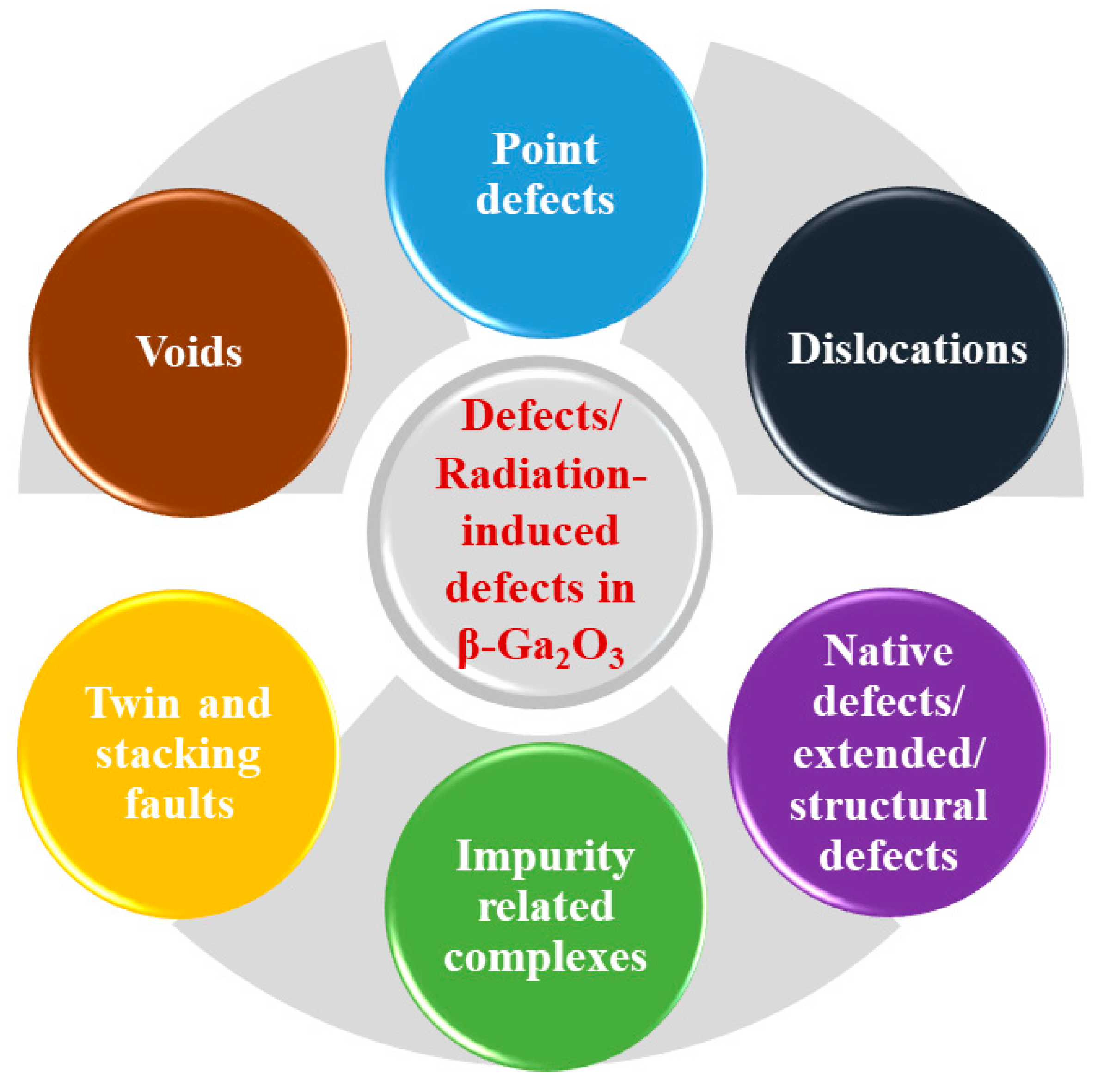
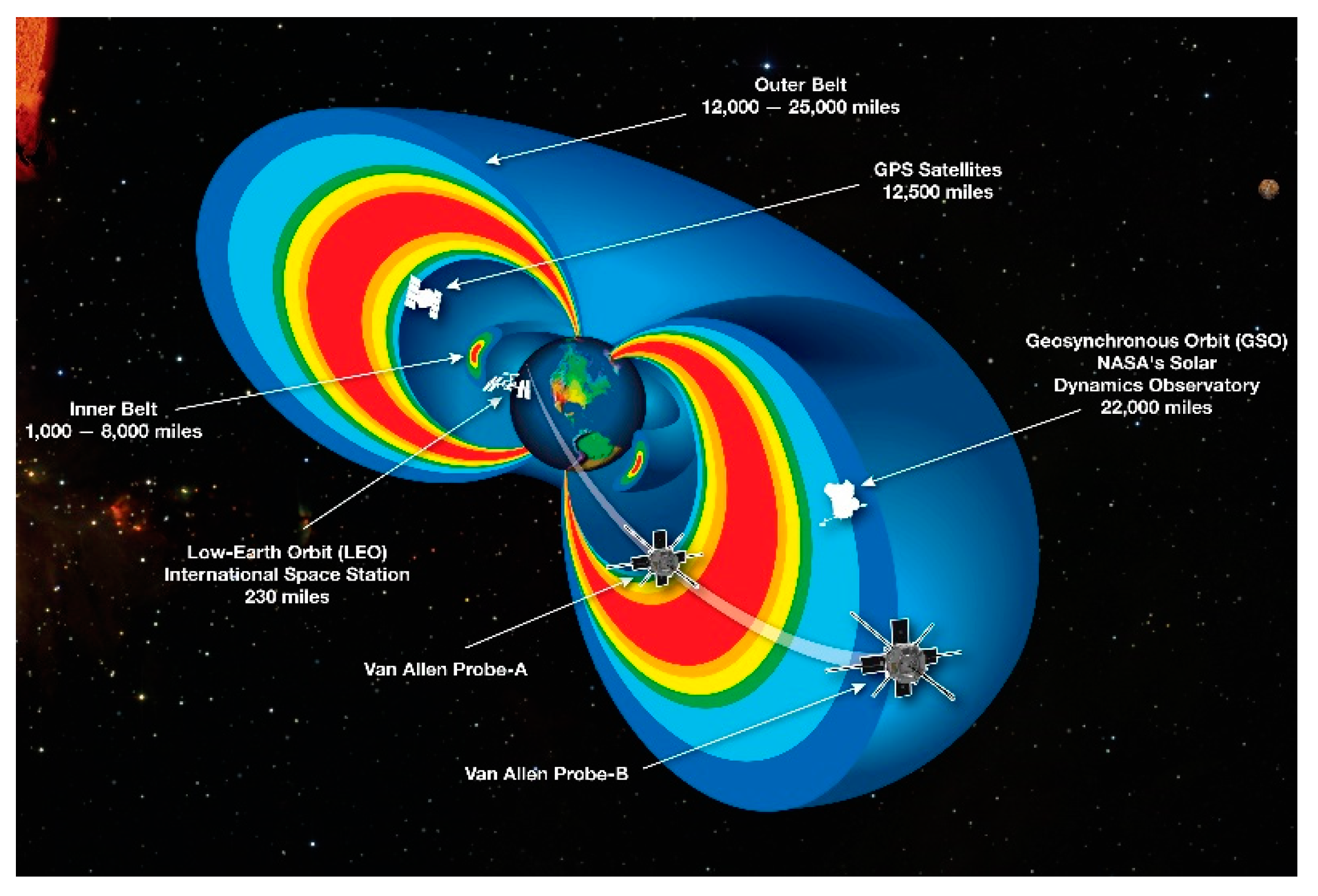



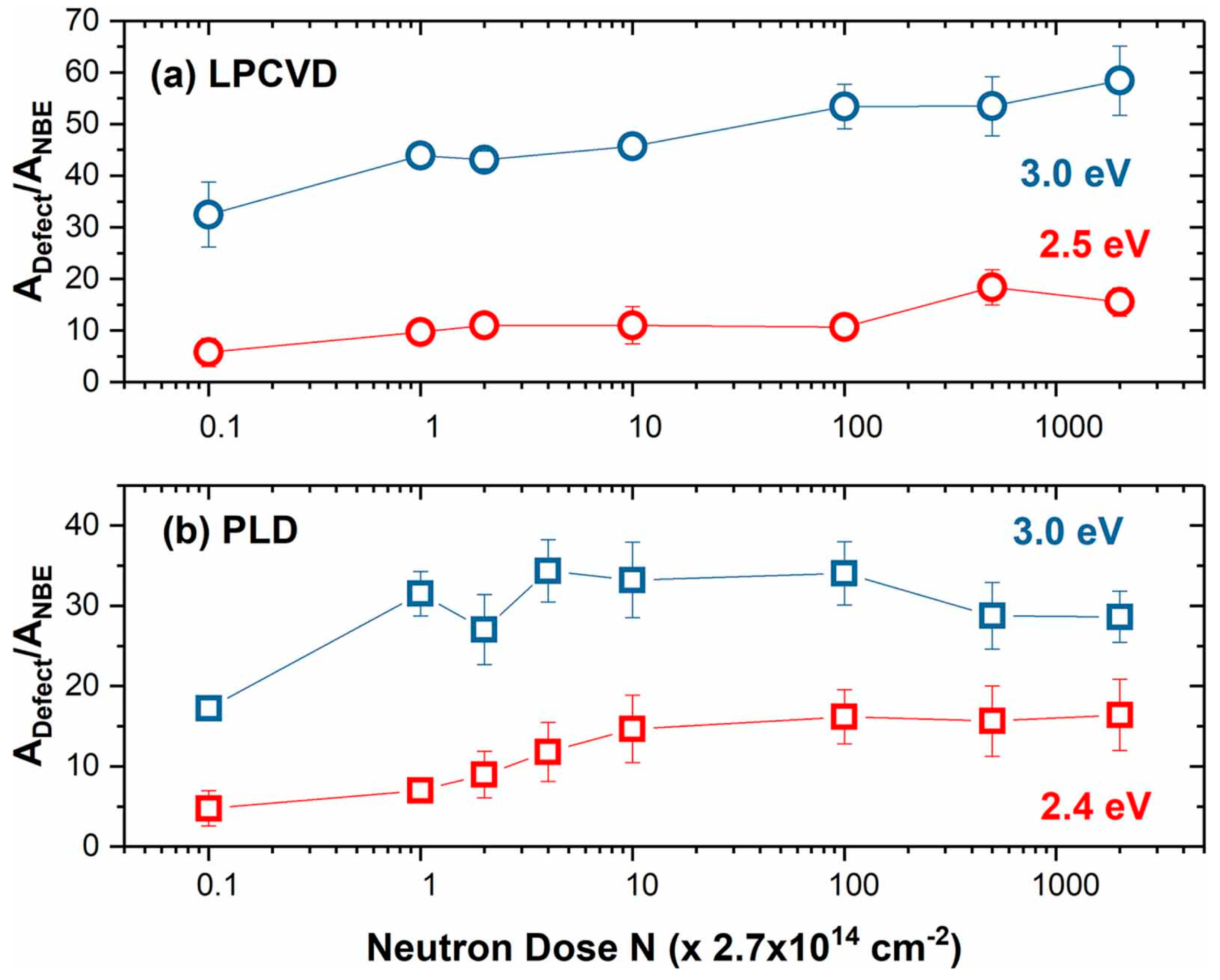
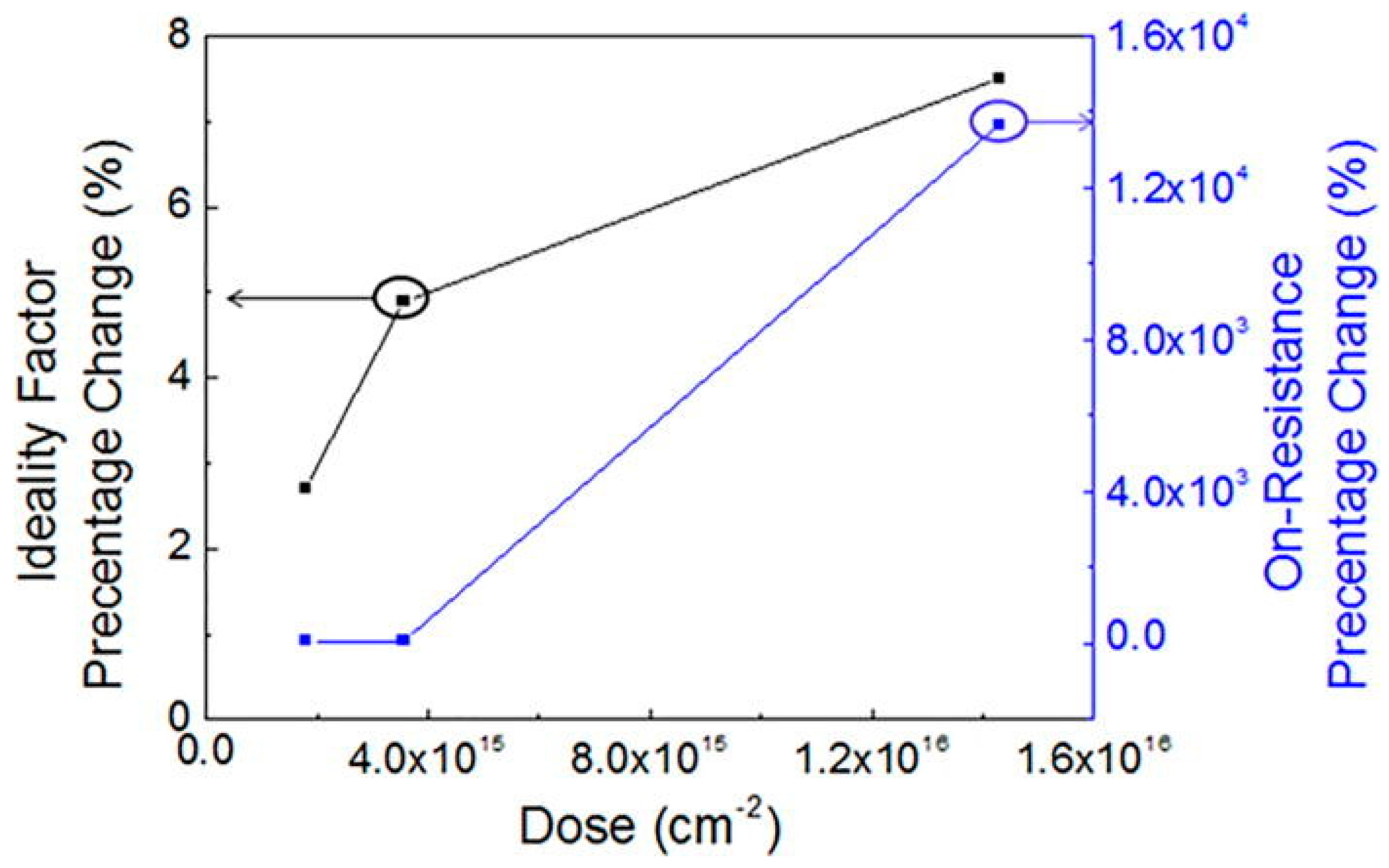
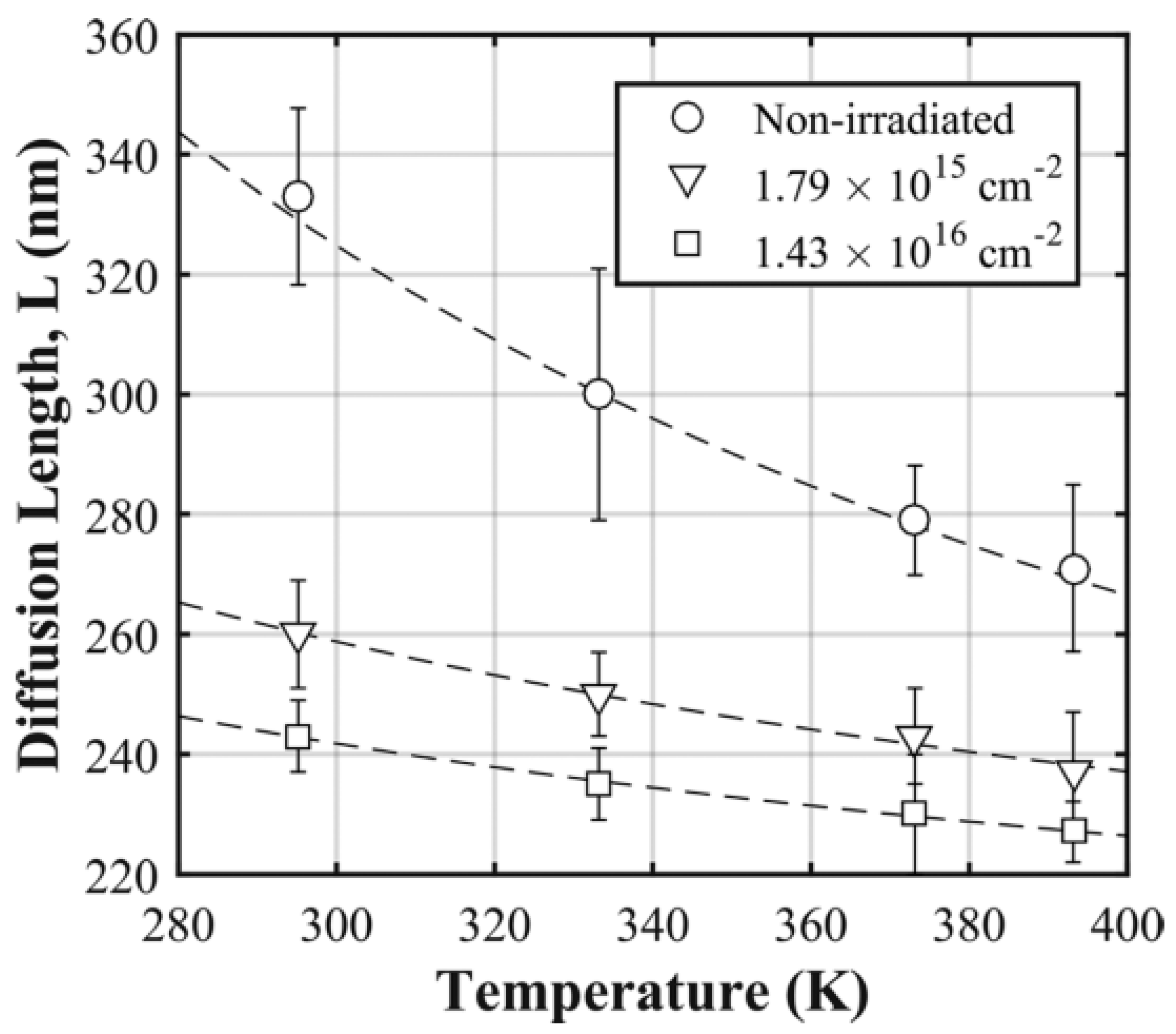
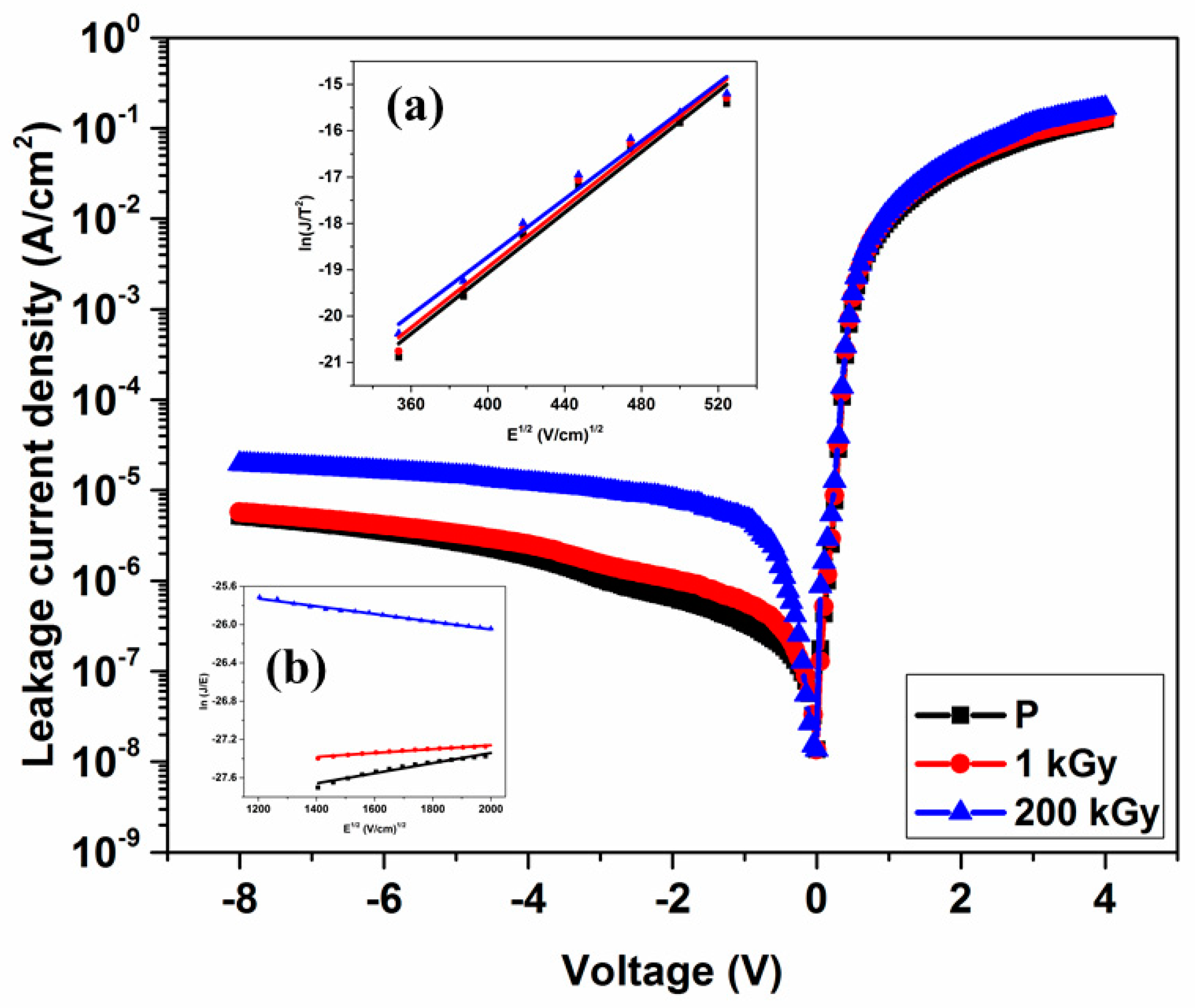
| Si | GaAs | 4H-SiC | GaN | β-Ga2O3 | |
|---|---|---|---|---|---|
| Bandgap Eg (eV) | 1.1 | 1.4 | 3.3 | 3.4 | 4.8–4.9 |
| Electron mobility μ (cm2V/s) | 1400 | 8000 | 1000 | 1200 | 300 |
| Breakdown field Ebr (MV/cm) | 0.3 | 0.4 | 2.5 | 3.3 | 8 |
| Relative dielectric constant ε | 11.8 | 12.9 | 9.7 | 9.0 | 10 |
| Baliga’s FOM, εμEbr3 | 1 | 15 | 340 | 870 | 3444 |
| Thermal conductivity (W/cmK) | 1.5 | 0.55 | 2.7 | 2.1 | 0.27 [10] |
Publisher’s Note: MDPI stays neutral with regard to jurisdictional claims in published maps and institutional affiliations. |
© 2022 by the authors. Licensee MDPI, Basel, Switzerland. This article is an open access article distributed under the terms and conditions of the Creative Commons Attribution (CC BY) license (https://creativecommons.org/licenses/by/4.0/).
Share and Cite
Manikanthababu, N.; Sheoran, H.; Siddham, P.; Singh, R. Review of Radiation-Induced Effects on β-Ga2O3 Materials and Devices. Crystals 2022, 12, 1009. https://doi.org/10.3390/cryst12071009
Manikanthababu N, Sheoran H, Siddham P, Singh R. Review of Radiation-Induced Effects on β-Ga2O3 Materials and Devices. Crystals. 2022; 12(7):1009. https://doi.org/10.3390/cryst12071009
Chicago/Turabian StyleManikanthababu, Nethala, Hardhyan Sheoran, Pradeep Siddham, and Rajendra Singh. 2022. "Review of Radiation-Induced Effects on β-Ga2O3 Materials and Devices" Crystals 12, no. 7: 1009. https://doi.org/10.3390/cryst12071009
APA StyleManikanthababu, N., Sheoran, H., Siddham, P., & Singh, R. (2022). Review of Radiation-Induced Effects on β-Ga2O3 Materials and Devices. Crystals, 12(7), 1009. https://doi.org/10.3390/cryst12071009







